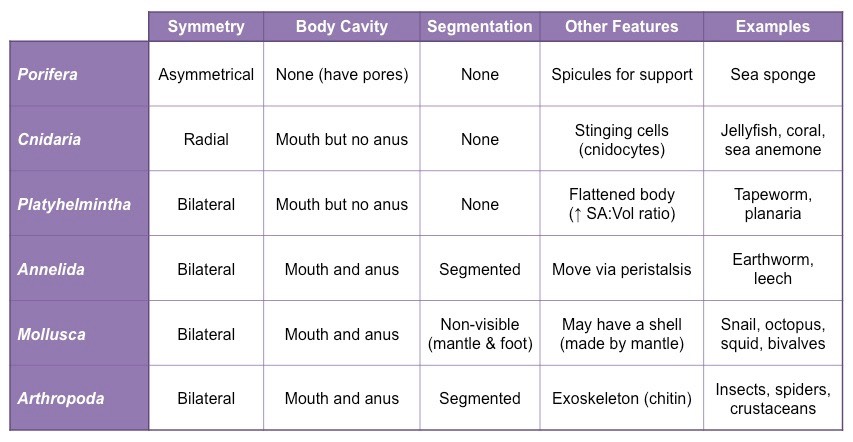![]()
Application:
• Recognition features of porifera, cnidaria, platyhelmintha, annelida, mollusca, arthropoda and chordata
The kingdom Animalia can be sub-divided into two main groups – invertebrates (no backbone) and vertebrates (most chordata)
- Examples of invertebrate phyla include porifera, cnidaria, platyhelmintha, annelida, mollusca and arthropoda
- All vertebrates belong to the phylum chordata – however not all chordata are vertebrates (e.g. invertebrate sea squirts)
- These phyla can be differentiated according to a few key recognition features
Porifera
- No body symmetry (asymmetrical)
- No mouth or anus (have pores to facilitate the circulation of material)
- May have silica or calcium carbonate based spicules for structural support
- Examples include sea sponges
Cnidaria
- Have radial symmetry
- Have a mouth but no anus (single entrance body cavity)
- May have tentacles with stinging cells for capturing and disabling prey
- Examples include jellyfish, sea anemones and coral
Platyhelmintha
- Have bilateral symmetry
- Have a mouth but no anus (single entrance body cavity)
- Have a flattened body shape to increase SA:Vol ratio and may be parasitic
- Examples include tapeworms and planaria
Annelida
- Have bilateral symmetry
- Have a separate mouth and anus
- Body composed of ringed segments with specialisation of segments
- Examples include earthworms and leeches
Mollusca
- Have bilaterial symmetry
- Have a separate mouth and anus
- Body composed of a visceral mass, a muscular foot and a mantle (may produce shell)
- Examples include snails, slugs, octopi, squid and bivalves (e.g. clams)
Arthropoda
- Have bilateral symmetry
- Have a separate mouth and anus
- Have jointed body sections / appendages and have a hard exoskeleton (chitin)
- Examples include insects, crustaceans, spiders, scorpions and centipedes
Chordata
- Have bilateral symmetry
- Have a separate mouth and anus
- Have a notochord and a hollow, dorsal nerve tube for at least some period of their life cycle
- Examples include mammals, birds, reptiles, amphibians and fish (also invertebrate sea squirts)
Invertebrate Phyla Recognition Features:

Overview of Invertebrate Phyla

